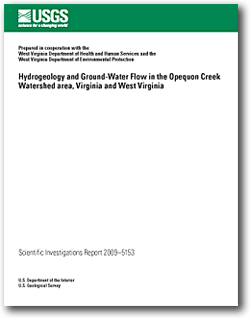Scientific Investigations Report 2009-5153
ABSTRACT
Due to increasing population and economic development in the northern Shenandoah Valley of Virginia and West Virginia, water availability has become a primary concern for water-resource managers in the region. To address these issues, the U.S. Geological Survey (USGS), in cooperation with the West Virginia Department of Health and Human Services and the West Virginia Department of Environmental Protection, developed a numerical steady-state simulation of ground-water flow for the 1,013-square-kilometer Opequon Creek watershed area. The model was based on data aggregated for several recently completed and ongoing USGS hydrogeologic investigations conducted in Jefferson, Berkeley, and Morgan Counties in West Virginia and Clarke, Frederick, and Warren Counties in Virginia. A previous detailed hydrogeologic assessment of the watershed area of Hopewell Run (tributary to the Opequon Creek), which includes the USGS Leetown Science Center in Jefferson County, West Virginia, provided key understanding of ground-water flow processes in the aquifer. The ground-water flow model developed for the Opequon Creek watershed area is a steady-state, three-layer representation of ground-water flow in the region. The primary objective of the simulation was to develop water budgets for average and drought hydrologic conditions. The simulation results can provide water managers with preliminary estimates on which water-resource decisions may be based. Results of the ground-water flow simulation of the Opequon Creek watershed area indicate that hydrogeologic concepts developed for the Hopewell Run watershed area can be extrapolated to the larger watershed model. Sensitivity analyses conducted as part of the current modeling effort and geographic information system analyses of spring location and yield reveal that thrust and cross-strike faults and low-permeability bedding, which provide structural and lithologic controls, respectively, on ground-water flow, must be incorporated into the model to develop a realistic simulation of ground-water flow in the larger Opequon Creek watershed area. In the model, recharge for average hydrologic conditions was 689 m3/d/km2 (cubic meters per day per square kilometer) over the entire Opequon Creek watershed area. Mean and median measured base flows at the streamflow-gaging station on the Opequon Creek near Martinsburg, West Virginia, were 604,384 and 349,907 m3/d (cubic meters per day), respectively. The simulated base flow of 432,834 m3/d fell between the mean and median measured stream base flows for the station. Simulated base-flow yields for subwatersheds during average conditions ranged from 0 to 2,643 m3/d/km2, and the median for the entire Opequon Creek watershed area was 557 m3/d/km2. A drought was simulated by reducing model recharge by 40 percent, a rate that approximates the recharge during the prolonged 16-month drought that affected the region from November 1998 to February 2000. Mean and median measured streamflows for the Opequon Creek watershed area at the Martinsburg, West Virginia, streamflow-gaging station during the 1999 drought were 341,098 and 216,551 m3/d, respectively. The simulated drought base flow at the station of 252,356 m3/d is within the range of flows measured during the 1999 drought. Recharge was 413 m3/d/km2 over the entire watershed during the simulated drought, and was 388 m3/d/km2 at the gaging station. Simulated base-flow yields for drought conditions ranged from 0 to 1,865 m3/d/km2 and averaged 327 m3/d/km2 over the entire Opequon Creek watershed. Water budgets developed from the simulation results indicate a substantial component of direct ground-water discharge to the Potomac River. This phenomenon had long been suspected but had not been quantified. During average conditions, approximately 564,176 m3/d of base flow discharges to the Potomac River. An additional 124,379 m3/d of ground water is also estimated to discharge directly to the Potomac River and represents approximately 18 percent of the total discharge to the Potomac River. |
First posted September 28, 2009 For additional information contact: Part or all of this report is presented in Portable Document Format (PDF); the latest version of Adobe Reader or similar software is required to view it. Download the latest version of Adobe Reader, free of charge. |
Kozar, M.D., and Weary, D.J., 2009, Hydrogeology and ground-water flow in the Opequon Creek watershed area, Virginia and West Virginia: U.S. Geological Survey Scientific Investigations Report 2009-5153, 61 p.
Abstract
Introduction
Hydrogeologic Setting
Simulation of Ground-Water Flow
Summary and Conclusions
References Cited
Appendix 1. Water levels and map coordinates for wells used in calibration of the ground-water flow model of the Opequon Creek watershed area, Virginia and West Virginia.
Appendix 2. Data for springs in the Opequon Creek watershed area, Virginia and West Virginia.